Principle of operation and design of a typical pumping station for water supply
Believe me, a private house can be equipped with such a high level of comfort that living in it will become much more convenient than in a city apartment. In any case, the water supply can be used with no less convenience. In the same way, to get water, you just need to open the tap, which is not yet very compatible with the suburban infrastructure, agree?
But this is not a "rainbow" dream. To implement the idea, it is enough to include a pump station in the water supply scheme. She will redo the colossal amount of hard physical work for the owners. True, for its competent connection and operation it is necessary to know the equipment device well.
We offer you valuable information on the specifics of using the aforementioned equipment. Our article will help to understand the principle of the pumping station and introduce the installation rules. The information we presented is supplemented by extremely clear diagrams, photo collections and video guides.
The content of the article:
Water supply station device
For organization water supply in a private house shops offer pumping stations in the form of a compact unit of a hydraulic tank, an automation unit and an electric pump. It is also possible to assemble a similar water supply unit from individual parts and equipment.
Both options are acceptable, but it is better to choose a ready-made kit with a manufacturer's warranty. This will cost less and more practical with further maintenance.
The main working components
According to the device, the water supply pump station assembled at the factory differs from the surface pump by the presence of a pressure control system.
The composition includes the following functional components:
- Surface electric pump.
- Hydraulic accumulator with a nipple and an internal rubber “bulb”.
- Pressure gauge.
- Pressure switch.
- Connecting fittings.
For water intake, a suction pipe with a check valve and a strainer is connected to it. And the main line is transported to the outlet of the installation, transporting the pumped liquid to the points of consumption. Moreover, if the station has a built-in filter and valve, then the suction hose can not be supplemented with them.
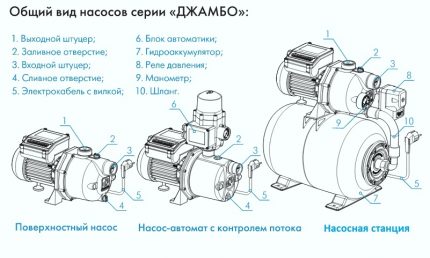
A hydraulic membrane tank, coupled with a centrifugal pump, is able to maintain a pressure of 1.5 atmospheres in the cottage's water supply. This is quite enough for the stable operation of all household appliances that are installed in private homes. And most of the models accumulators it is designed for 4.5 atmospheres of the maximum possible pressure, which is more than enough even for a cottage with two or three floors.
The automatic station is compact and does not require heavy concreting of the site under the equipment. Its largest element is a water storage tank. However, its installation requires a separate room due to the hum created during operation. Most often, the entire installation is mounted on the ground floor or in the basement, where it is most convenient to operate and maintain it.
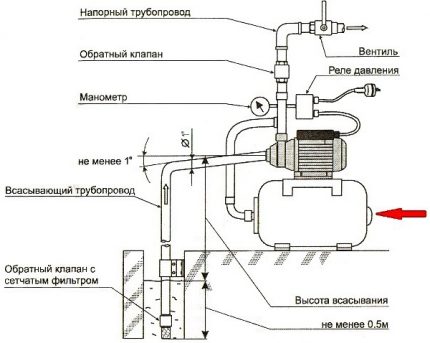
A somewhat expensive, but quite reasonable solution for equipment placement may be a caisson, in which both the entire complex of units and a pump with automatic equipment without a hydraulic tank installed in the house can be located. The budget option for the location of the station in the country involves the installation of a separate pavilion that protects the unit from atmospheric negative.
Work and features of the control unit
The task of the control pumping station of automation includes monitoring the pressure in the system and turning on / off the hydraulic pump engine as necessary. For this, the control unit includes a pressure gauge and relay. The first controls the current pressure, and the second controls the pump.
The main elements of the relay are two springs.The larger one is configured to close the circuit at the lowest pressure in the membrane tank when there is little water in it. A smaller one controls the maximum pressure, breaking the circuit when the latter is reached.

When buying a pumping station to work in circuits with the probability of short-term operation without water, you must pay attention to the presence of a flow controller device.
It is designed to protect the engine from overheating in the absence of water in the intake. In such units, the control unit is not focused on pressure limits, but on a decrease in flow.
In how competently pick up a pumping station for arrangement of a summer cottage, the article proposed by us will help to understand. In addition to valuable recommendations to equipment buyers, it provides a rating of the best deals in the domestic market.
The interaction of the pump with a hydraulic accumulator
The capacity of the membrane tank is selected taking into account the volume of water consumption. A couple of 25–40 liters is quite enough for a married couple, and for a family of several people you will have to select a device from 100 liters.
Tanks of less than 15 liters are recommended to be bought only for seasonal use in the country. Due to the constant pumping of water, the membrane in them wears out quickly.

It is believed that the larger the capacity, the longer the pumping equipment will last, because the number of on / off cycles will decrease. However, a large capacity tank costs a lot.
According to the rules, the hydraulic tank is selected on the basis of calculations based on the on and off pressure values indicated by the manufacturer, the actual water flow when the water intake points are turned on at the same time.
The fluid reserve in the hydraulic tank is usually about one third of the total capacity. All the remaining space is given under compressed air, which is needed to maintain a constant pressure of water in the pipes.
If a hydraulic accumulator is built into the water supply system to minimize the risks associated with the hydraulic reservoirs, then the tank can be selected in a small size. In this case, it is not the volume of the container that matters, but the presence of the membrane and the air behind it. It is they, in which case they will take the brunt, smoothing out its consequences.
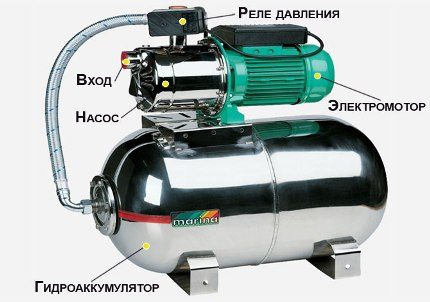
The automatic pump station operates in two cycles:
- First, water is pumped into the hydraulic accumulator by a pump from the water intake, creating excessive air pressure in it.
- When the tap is opened in the house, the membrane tank is empty, after which the automation starts up the pumping equipment again.
The accumulator device for a water supply pumping station is extremely simple.It consists of a metal case and a sealed membrane that divides the entire space inside into two parts. In the first of them is air, and in the second, water is pumped.

After filling the accumulator, the relay switches off the pump. Opening the faucet in the washbasin leads to the fact that water squeezed out by pressing air on the membrane begins to flow gradually into the water supply system. At some point, the tank is emptied to such an extent that the pressure weakens. After that, the pump turns on again, starting the cycle of the pumping station for a new one.
With an empty tank, the membrane membrane is crushed and pressed against the inlet flange. After turning on the hydraulic pump, the membrane is expanded with water pressure, compressing the air part and increasing the pressure in it already of air. It is this interaction of gas-liquid through a changing barrier that lies in the principle of operation of the membrane tank of the pumping station.
Equipment Selection Criteria
Factory-built pumping stations come with a surface hydraulic pump, often with an internal or external ejector. However, accumulators can also be used with submersible pumping equipment, but they are assigned a slightly different technical term “pumping system”.
When working in tandem with a station, diaphragm tanks may be smaller than hydraulic tanks for systems with submersible pumps. This is due to the fact that for submersible pumping units the number of permissible on / off times per hour is less than for surface pumping machines.

Surface pumpshaving an internal ejector have serious restrictions on the depth of water intake. They can raise water only from 7-8 meters. However, they give out powerful water pressure at the outlet with a column of water of 40-60 meters (4-6 bar).
The internal ejector is not afraid of air jams. They first pump air without any negative consequences for themselves, and then they begin to pump water from the well into the system.
The main disadvantage of stations with an internal ejector is the high noise level during operation. If these models of pumping equipment for autonomous water supply are planned for installation in an honest house, then it is recommended to do this only in the utility rooms with good sound insulation.
Using remote ejector allows you to take water from depths up to 50 meters. These pumps are more economical, but have low efficiency (no more than 40%). But they emit much less noise than analogues with a built-in ejector.
The choice of the type of pumping unit for the station depends on the quality characteristics of the medium planned for pumping:
Locating a Water Station
Choosing a location for the pumping station, it is necessary to focus on the characteristics of the hydraulic pump. Every ten meters of a horizontal pipe between the water source and the pump reduces its suction capacity by 1 m.
If they are supposed to be spaced at a distance of more than ten meters, then the model of the pumping unit must be selected with an increased suction depth.
The automatic station of the autonomous water supply system can be located:
- on the street in a caisson near the well;
- in an insulated pavilion built specifically for pumping equipment;
- in the basement of the house.
Stationary outdoor option provides arrangement of caisson and laying a pressure pipe from it to the cottage below the level of freezing of the soil. When installing a year-round operated pipeline, laying it below the depth of seasonal freezing is required.
When arranging temporary summer highways for the period of residence at the dacha, the pipeline does not burrow below 40-60 cm or is laid on the surface.

If you install the station in a basement or basement, you do not have to fear the pump freezing in winter. It is only necessary to lay the suction pipe below the freezing boundary of the soil so that it does not freeze into severe cold.
Often a well is drilled directly in the house, then the length of the pipeline is significantly reduced. But not in every cottage such drilling is possible.
Installation of water supply pumping stations in a separate building is possible only if the equipment is operated in a period of positive temperatures. However, for areas with very low winter temperatures, such an option, designed to function year-round, it is necessary to insulate or arrange a heating system. It is better to immediately install a pump station directly in a heated house.
When choosing a place for the location of the water supply station, it is necessary to take into account the temperature limits indicated in its passport by the manufacturer:
Pressure accumulator parameters
For proper operation of household plumbing devices in the cottage water supply, it is necessary to maintain a pressure of 1.4–2.6 atmospheres. To prevent the accumulator membrane from wearing out too quickly, manufacturers recommend setting a pressure 0.2-0.3 atm higher than the water supply.
The pressure in the water supply of a one-story house is usually 1.5 atm. This figure should be based on when adjusting the hydraulic tank. But for larger residential buildings, the pressure must be increased so that the water is in all the taps farthest from the riser. Here we need more complex hydraulic calculations, taking into account the length and configuration of the pipelines, as well as the number and type of plumbing devices.
It is possible to simplify the calculation of the required pressure for an intra-house water supply using the formula:
(H + 6) / 10,
where "H" is the height from the pump to the highest point of water supply to the plumbing on the top floor of the house.
However, if the calculated indicator pressure in an autonomous water supply If it exceeds the permissible characteristics of the existing plumbing and household devices, then when this pressure is set, they will fail. In this case, it is necessary to select another scheme for the layout of water pipes.
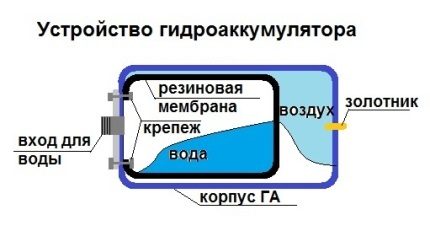
Possible problems with the installation
If the pump switches on too often and immediately turns off, you must immediately check the air pressure in the accumulator. With low indicators, it will be necessary to pump it up. But to fix the problem in this way will only be possible if the membrane and the tank body are not damaged. Here, only contacting the service center to the repairmen will help.

If water droplets appear on the nipple of the air valve, the accumulator must be immediately disconnected from the plumbing system. This is a direct sign of membrane damage. One cannot do without its replacement in a similar situation. Air should not enter the water supply system of a private house through a membrane tank.
If the pump does not want to turn on at all, then it is worth looking at pressure switch adjustment. There are times when it is set to too high a pressure. But it is also possible with air entering the suction hose, which leads to the protection against dry running.
Advantages of the pumping unit with a hydraulic tank
The pump unit is an integral part of an autonomous water supply system. It provides water from a well or a well, the water distribution of which is further down the cottage due to the operation of the pump itself, the use of a water tank or the use of a hydraulic accumulator.
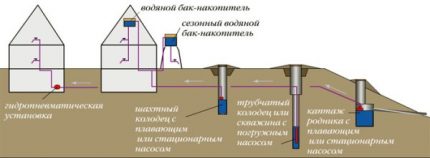
Using only one pump when distributing water to a cottage is fraught with many problems. With this arrangement autonomous water supply pumping equipment is forced to constantly turn on / off, which is why its service life is drastically reduced. And in a situation with a power outage, the house is completely without water.
To reduce pump wear and protect the house in case of accidents on electrical networks, an additional drive is included in the water supply system of the house. This can be a water tank in the attic, from which water to plumbing fixtures flows by gravity, or a pressure accumulator that maintains the pressure in the network artificially (it is also a membrane tank or a hydraulic tank).
In both cases, the pump is turned on to form a supply of water in the tank. Only in the second case, the reserve is created in automatic mode by the pressure control system. At the same time, the storage tank allows you to create a reserve of water in case of a power outage, and a system with a hydraulic tank without electricity will not work at all.
However, the drive in the filled state is notable for its considerable weight, and when installed within the attic, it requires strengthening of the ceiling and thermal insulation.
The option with a membrane tank is more convenient and practical. The principle of operation of the water supply system with such a pumping station is based on the artificial maintenance of water pressure in the pipes. The pump itself, pumping water from the intake, is turned on only to fill the tank. Further, its supply to the system is carried out using compressed air.

Unlike the expansion tank version, the hydropneumatic installation is more compact. Plus, the use of a membrane-type accumulator ensures no water hammer network and constant pressure in the water pipes, and also simplifies the maintenance of the water supply system of consumers in a private house.
The only drawback of pumping stations with a hydraulic accumulator is their volatility. The water storage tank often has a small size of 25-50 liters. The pump has to be turned on often to fill it, and when the light is turned off, the water reserve is not enough for too long. In order to exclude such situations, it is advisable to stock up on an autonomous generator.
Conclusions and useful video on the topic
Clip # 1. From what depths can pumping equipment lift water:
Clip # 2. How to assemble a pump station yourself from a household centrifugal pump:
Clip # 3. All about the principle of operation of the accumulator, which is part of the pumping station:
Automatic autonomous water supply systems make it possible, when living in a country house, not to bother carrying water in buckets. Thanks to their simple design, pumping stations are easy to install and maintain.
Almost anyone can cope with their installation. Fortunately, there are many configurations of pumping equipment of various types with accumulators, for each cottage you can choose the best solution.
Do you want to share your own experience in using a pumping station, have questions or find flaws in the article? Please write comments in the block below.

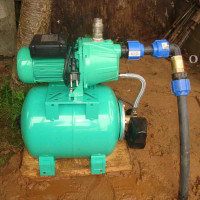 Ejector for a pumping station: operating principle, device, installation rules
Ejector for a pumping station: operating principle, device, installation rules  Connecting a pumping station to a well: rules for organizing autonomous water supply
Connecting a pumping station to a well: rules for organizing autonomous water supply 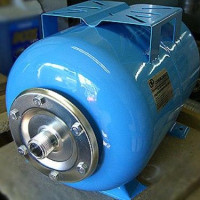 Hydraulic accumulator: device and principle of operation of a hydraulic tank in a water supply system
Hydraulic accumulator: device and principle of operation of a hydraulic tank in a water supply system 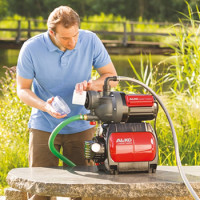 Adjustment of the pumping station: rules and algorithm for setting up the equipment
Adjustment of the pumping station: rules and algorithm for setting up the equipment 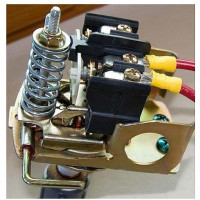 How a pressure switch for a pumping station works + rules and features of its adjustment
How a pressure switch for a pumping station works + rules and features of its adjustment  Do-it-yourself pump station repair: typical malfunctions and solutions
Do-it-yourself pump station repair: typical malfunctions and solutions  How much does it cost to connect gas to a private house: the price of organizing gas supply
How much does it cost to connect gas to a private house: the price of organizing gas supply  The best washing machines with dryer: model rating and customer tips
The best washing machines with dryer: model rating and customer tips  What is the color temperature of light and the nuances of choosing the temperature of the lamps to suit your needs
What is the color temperature of light and the nuances of choosing the temperature of the lamps to suit your needs  Replacement of a geyser in an apartment: replacement paperwork + basic norms and requirements
Replacement of a geyser in an apartment: replacement paperwork + basic norms and requirements
We have a small one-story house with a kitchen, shower room and 3 rooms. We have installed such a station. In our case, it was assembled at the factory. That is, the control system is debugged according to standard pressure values, and besides, everything can be controlled. The master arrived and installed everything, but fiddled for a long time. The station has been operating for a year, and in general there are no problems so far, it is not leaking anywhere. I heard that the neighbors had various problems. We are afraid of this, since they themselves are not techies, but we hope that we will find masters, if that. In general, we are satisfied with the installation. We have a volume of 40 liters, but the two of us have enough, we don’t spend much.
In what cases do I need to purchase a pumping station? You live in your house with your wife (children grew up and live separately), convenience in the yard, love to wash in the bath (thank God, now this is not a problem), a well on the site. Well, why spend a lot of money to deliver two buckets of water to the kitchen? But you have a warm toilet, bathtub (jacuzzi), shower, washing machine in the kitchen, dishwasher, then without a station you can not physically live!
If a private house needs normal water supply, then the installation of a pumping station is justified. Type and power are already calculated based on needs, remoteness of the source, and more. Of course, there are people for whom convenience on the street is the norm. But in winter, for example, many of them think for sure that the water supply in the house now would be very welcome.
The implementation of the simplest pumping station will not cost so much to save and abandon everyday things for many, like water in the house!
The house is 250 m from the lake, what pumping equipment would you recommend? We want to put a submersible pump in the lake, then 250 m, an HDPE pipe, then in the caisson a surface pump, a hydraulic accumulator, and a pressure switch. Will this work?
Since your house is located at a considerable distance from the lake, here you need to consider many factors. For example, elevation differences for a distance of 250 m play a very important role. Accordingly, the greater the difference, the more power is needed for the pump to ensure a normal water supply.
I attach for you a detailed diagram of the water supply of the house from the lake. It is not difficult to add a caisson, a hydraulic accumulator and a pressure switch here. The last element will need to be manually calibrated so that there are no interruptions in the water supply. The site has current instructions on this subject.
In general, you have a very good idea, but I am concerned about the difference in elevation. If the slope to the lake is not very steep, then no difficulties should arise.
Good evening! I bought a house, a pump station is installed in it, which consists of a relay, a filter, a submersible pump and an engine that is displayed on the street (fixed to the wall of the house). This engine runs noisy and constantly.
My question is - should the engine run continuously? And can it be placed on the street, in the cold? Thank!
If the noise of the electric motor bothers you, then here are two options for solving the problem: move it to another location or install a different type of pump. Regarding the operation of the electric motor in cold weather, it all depends on the model, but I think that it is unlikely that it will work normally at -20 * С.
Is it permissible to disconnect the pumping station for 2-3 days upon departure and how to connect later?
As I understand it, you already have a pumping station for supplying water to the house. Disconnecting it is not particularly necessary, since this equipment should work in automatic mode. The specialists who installed the station for you should have been instructed for you, including regarding the shutdown of the pump station.
I advise you to call the company to get advice on this issue or look in the technical documentation that you must have.
If you want to get an answer from me, then name the make and model of your pumping station.
Good afternoon. Two Jumbo 60/35 water supply stations were installed. Connected to the water supply network in parallel. Tell me, do I need to install a check valve on the supply pipes (when using two stations at the same time)? A check valve is installed on the suction nozzles. The source of water for pumping is capacity.
Good afternoon, Ruslan. If you had only one pump station installed, you would not need a check valve on the supply pipe. But since in your case two stations are connected in parallel, there may be drops in pressure or some other failure (for example, one station will turn off).
Therefore installation check valves on the supply nozzles - this is a necessary precaution, which will help maintain the integrity of the equipment in case of emergency.
There is nothing complicated in the wiring diagram, it is necessary to duplicate the check valves. If you attach your wiring diagram, then I can give more precise recommendations.